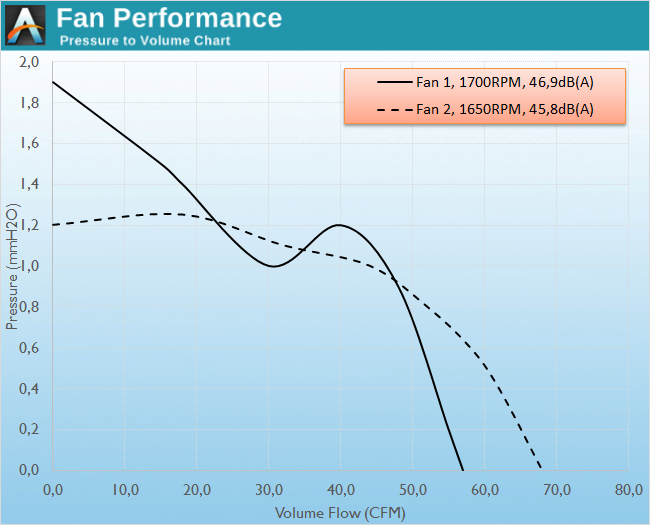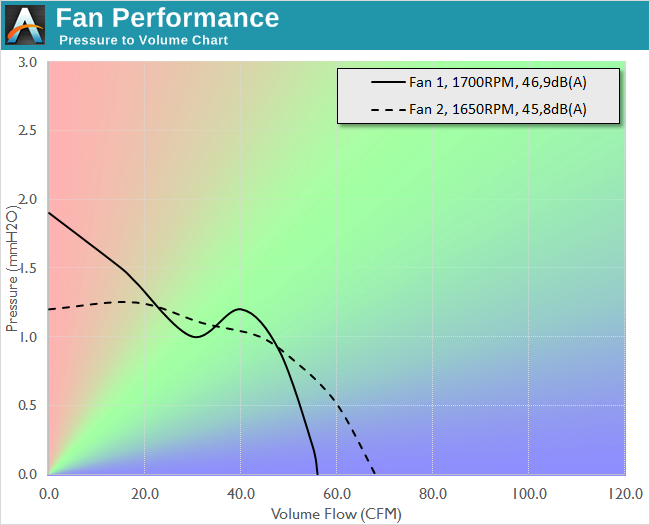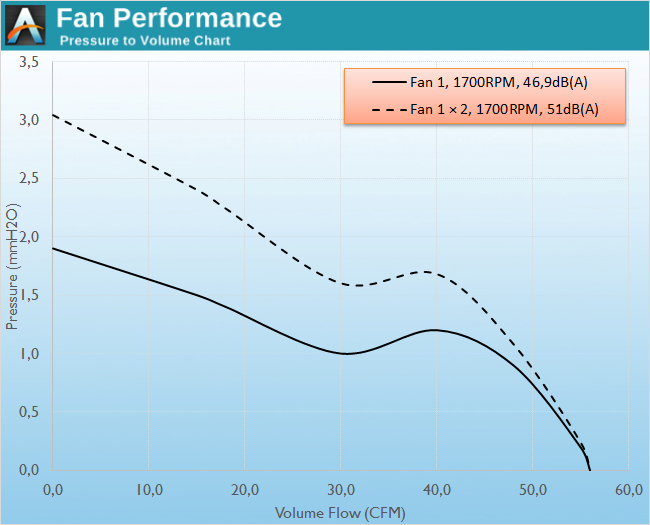The Corsair SP (Static Pressure), AF (High Airflow) 120/140mm Fan Review
by E. Fylladitakis on November 25, 2015 8:00 AM ESTFan Testing Methodology
For our first fan review we want to talk about the performance of fans and discuss how we will be testing them in our upcoming articles. This will serve as both a reference point for readers and manufacturers, as well as a chance to receive feedback and input on what we're doing before our first roundups start coming out. A large percentage of computer users are unconcerned with the actual performance of any given fan; most base their choices on recommendations and are swayed by marketing claims of "noiseless operation" and "astounding performance". Advanced users and enthusiasts are using up a lot of grey matter on the topic, seeking to find the best possible solution over dozens of possible choices. Regrettably, even if the user possesses the will and the knowledge to select a product suitable for his/her needs, they are often limited to the manufacturer's specifications, which usually are vague at best.
The fan manufacturers typically provide only a few performance figures, such as the static pressure and maximum volume flow ratings of a fan. However, even if these figures are 100% accurate (and they frequently are not), they are entirely useless to the end consumer. There are many who believe that a high static pressure rating is good for coolers and a high volume flow rating is good for case fans, but this is far from accurate. Maximum static pressure is taken at zero volume flow and maximum volume flow means zero static pressure; either scenario is impossible under real-world conditions. Furthermore, the maximum volume flow is usually calculated from the maximum velocity recorded at the exit of the fan. This is also entirely unrealistic as the fluid flow will definitely not be even across the entire exit area of the fan. The result is that retail products tend to have actual volume flows significantly lower than their specified maximum CFM ratings.
To measure the actual performance of a fan, the user has to know the P-Q (pressure to volume) chart of the fan. Here we measure the amount of applied pressure restriction, measured in mmH2O (where 1 mm H2O is the equivalent of 9.81 Pascals - one Pascal is the pressure required to accelerate 1 kg of mass at a speed of 1 meters per second squared per square meter) required to give a specific volume flow (measured in cubic feet per minute or CFM). The more the flow is restricted, the less volume flow is generated and the higher the pressure of the fan is. Still, some of the computer users who actually know how to interpret a P-Q chart are frequently misconceived that a P-Q chart is depicted by a straight line, such as this:
This is the misconception about pressure to volume - reality is a non-linear response
Unfortunately, this could not be further from the truth. The shape of the curve varies between the maximum static pressure and maximum volume flow rating, depending on several dozens of factors, mainly having to do with the design of the blades and the torque (the pushing power) of the engine. As such, two near-identical fans can have completely different behavior, which can be muddied by the actual 'naming' of the fan as an added element of confusion.
For example, the following chart depicts the P-Q chart of two fans. The first fan has a higher static pressure rating than the second and they both have an equal maximum volume flow (on paper), yet the second fan is a better selection for use as a case fan as it performs better when there are few obstructions.
Fan 2 is preferred in low impedance scenarios (low mmH2O)
as it gives higher airflow (>60 CFM under 0.6 mmH2O)
Unfortunately, the calculation of the impedance (resistance to move air) the fan will face by a grill/cooler/radiator/filter can be very difficult to assess without specialized equipment. It can be measured but it depends on far too many variables, including several environmental figures, such as the temperature and the air density. Even if we did extract a specific graph for every single part, the actual graph would be different for every single user. Therefore, it is not practical to give a graph depicting the exact impedance that an item has. It is however possible to provide an usable estimate, which we will be doing so in our future cooler and radiator reviews. The impedance of different items that can restrict the airflow looks like this:
Where the impedance line intersects with the fan's performance curve, that's where the fan will operate.
So a low impedance item generates 0.3 mm H2O of pressure and hits the fan curve at ~63 CFM in this case.
The green line depicts a high impedance item, such as a very dense liquid cooling radiator. The purple line is for a medium impedance item, such as a cooler. The black line is for a low impedance application, such as a case fan with a simple finger guard or a clean filter. For example, the medium impedance item in the graph above would have the fan moving about 32 CFM. There are no actual conditions under which the actual performance of a fan will go very near its maximum static pressure point nor will a fan will reach its maximum volume flow. This allows us to provide a usable estimate when testing coolers, radiators and similar devices. For example, a "very high impedance" radiator would lean towards the left side of the red area, while a "medium to low impendance" cooler would lean towards the right side of the green area.
Where the impedance line intersects with the fan's performance curve, that is the aiflow impedance pressure drop, or by how much of a pressure drop the device (cooler, radiator, filter, etc.) will cause to a fan. Note that the impedance line is highly unlikely to intersect at the same airflow impedance pressure drop point for different fan performance curves. As such, the pressure drop is not something that can be universally assessed for each application but depends on the fan itself as well.
We will be using the above style of graph for the delivery of our results, maintaining the same axes for 120mm/140mm fans for easy comparisons. The red, green and blue areas should be consulted for high, medium and low impedance applications respectively. Even if the axes do shorten, note that the areas remain nearly identical if the range of both axes is reduced by the same percentage.
When the expected obstruction is high, some manufacturers use two fans in series (a push-pull configuration). This is often the case with liquid-cooling radiators. When two fans are placed in series, their pressure at a given airflow is increased (but not doubled) and thus the airflow at a given pressure point is increased, as seen in the following example.
Using two fans in a push/pull configuration.
Thus at a static pressure of 1.5 mmH2O (medium impedance device, such as an air cooler), volume flow increases here from 15 CFM to 43 CFM. However, their maximum airflow will always be the same; therefore, this approach makes no sense when the impedance is low and only in high static pressure situations.
How AnandTech Will Test Fans
We will begin testing fans using an Extech HD350 differential manometer with a Pitot tube, an Extech AN200 velocity meter, and a custom apparatus designed for this specific purpose. The apparatus has a mechanism that allows us to test the unobstructed (maximum) volume flow of a fan, the fully obstructed (maximum static) pressure of the fan, and multiple points in between, allowing us to compose the actual P-Q performance chart of any fan. However, we are measuring the actual airflow generated by the fan, not that calculated by our maximum recorded air velocity.
For noise measurements, we are using an Extech HD600 high sensitivity SPL meter. The noise of the fan is measured from 15 centimeters away, not one meter as IEC certifications require, as that would be far too great a distance to measure differences between nearly silent products. Note however that we are measuring the noise level of a fan with its flow unobstructed. The addition of far grills, the installation on a cooler, and any other form of obstruction will increase the generated noise, as aerodynamic noise will be added into the environment.
We also plan on testing fans at their "stock" 12 V PC voltage and at a lower voltage, which will most usually be 7 V. This may not always be practical on some fans (i.e. very low speed fans may have their performance degraded far too much), but when it is we will do so. While it's impossible to state how any fan will perform in every situation, we will be able to provide at least a more rigorous view of each fan's performance. In the meantime, any feedback on our approach to testing or requests for additional tests is welcome.















92 Comments
View All Comments
Gonemad - Friday, November 27, 2015 - link
Too bad I couldn't find the non-led versions around here in time and budget; I'm sick and tired of that blue glow emanating from a case when you need some sleep. I got a case with thick foam filters (Tt Armor), so SP fans for me all the way (3rd rebuild in this case). Fewer, thicker blades is what I am looking for. No care for loud fans, since the graphic card makes the point moot.jhh - Sunday, November 29, 2015 - link
Yes, I got a similar case, and was given significant spousal input that the extra light had to go. A little bit of time with a wire cutter extinguished the LEDs, but am still left with the inferior fans.Gonemad - Monday, November 30, 2015 - link
I thought the same thing about the wire cutters, but I'd need to take the whole thing apart and search the proper wire to cut on the led ones I got. Not gonna happen, can't be ars... bothered.TelstarTOS - Saturday, November 28, 2015 - link
Very good article, but performance/noise charts and analysis are missing. I.e. in this case I'm not even sure that SP perf and quiet versions have same noise at let's say 1200rpm.EddyKilowatt - Thursday, December 3, 2015 - link
Cool stuff, guys. I appreciate the detail, and I appreciate even more that you didn't couple it to a self-deprecating "if your eyes haven't glazed over yet" type comment, all too common in the popular press when the going gets technical. AT continues to differentiate itself, *and* increase its credibility.juliabrown943 - Thursday, December 3, 2015 - link
what Jeffery said I am impressed that some one able to make $8960 in one month on the computer . you could try this out...............................juliabrown943 - Thursday, December 3, 2015 - link
what Jeffery said I am impressed that some one able to make $8960 in one month on the computer . you could try this out............................... earni8samsp99 - Monday, December 7, 2015 - link
To PWM or not to PWM?Does undervolting a fan to 7v have the same effect as a PWM fan set to 70% ? Is the static pressure and noise the same when flow is somewhat impeded?
TheRealAnalogkid - Monday, December 7, 2015 - link
I am greatly offended that I didn't something blah blah my rights blah blah my Dad's an astronaut bippy-boppity thar tekken ar jerbs.Oh, and thanks for starting fan reviews.
kaesden - Monday, January 4, 2016 - link
do these fans have PWM connectors or just the 3 wire connectors?